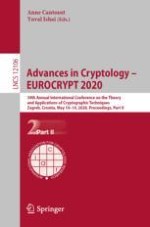2020 | OriginalPaper | Buchkapitel
Finding Hash Collisions with Quantum Computers by Using Differential Trails with Smaller Probability than Birthday Bound
verfasst von : Akinori Hosoyamada, Yu Sasaki
Erschienen in: Advances in Cryptology – EUROCRYPT 2020
Aktivieren Sie unsere intelligente Suche, um passende Fachinhalte oder Patente zu finden.
Wählen Sie Textabschnitte aus um mit Künstlicher Intelligenz passenden Patente zu finden. powered by
Markieren Sie Textabschnitte, um KI-gestützt weitere passende Inhalte zu finden. powered by
